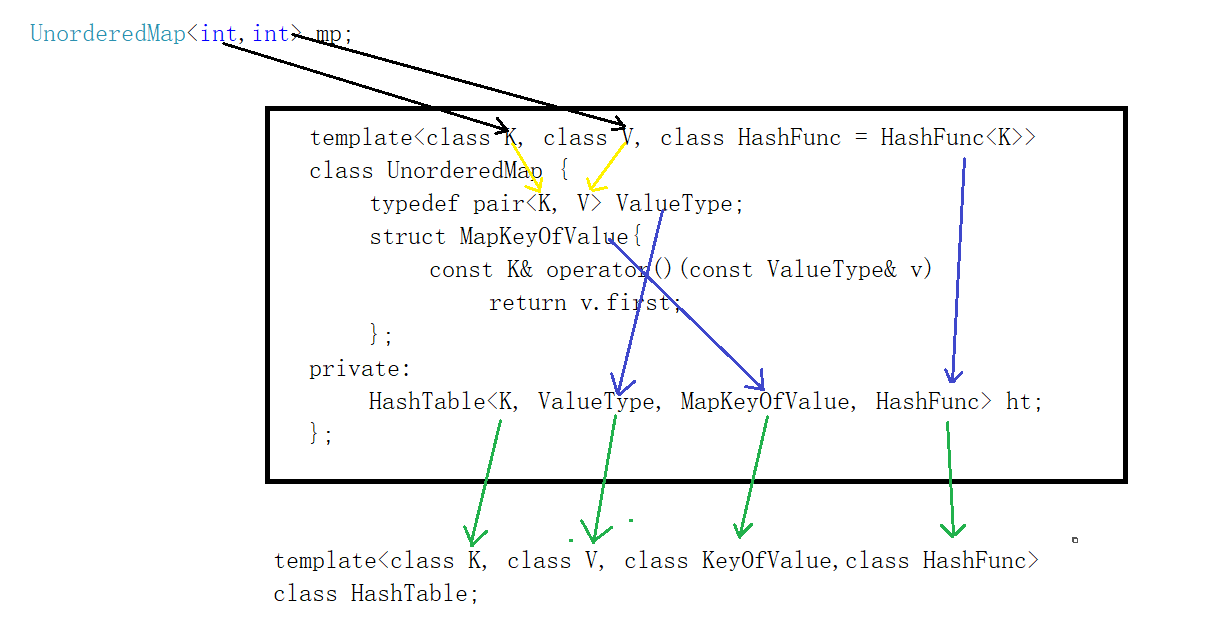用哈希表封装unordered_map/set
上一篇博客我们讲了哈希表(戳这里查看上一篇博客),这篇博客我们来用已经实现的哈希表来封装出unordered_map/set,我们以前讲过用红黑树封装map/set,其实这里也是换汤不换药,原理基本一模一样,只不过是哈希表有4个模板参数,通过这篇博客,你对哈希表的4个模板参数一定会有新的理解。
unordered_map
同样我们用unordered_map来举例,会了unordered_map你也肯定会unordered_set了,这里我们先来看看Umap(简写一下)的基本框架:
template<class K, class V, class HashFunc = HashFunc<K>>
class UnorderedMap
{
typedef pair<K, V> ValueType;
struct MapKeyOfValue
{
const K& operator()(const ValueType& v)
{
return v.first;
}
};
public:
//...
private:
HashTable<K, ValueType, MapKeyOfValue, HashFunc> ht;
};
我们把哈希表的4个模板参数也拿出来看看:
template<class K, class V, class KeyOfValue, class HashFunc>
class HashTable
- class K:很容易理解,K就是传给哈希表用来映射取模的key
- class V:对于Umap来说V是要映射到哈希表的值,但是对于HashTable来说ValueType可能是pair类型也可能是K类型
- class KeyOfValue:这里是取K值的仿函数,如果是pair<K,V>类型就需要返回K(MapKeyOfValue)
- class HashFunc:这个模板参数非常重要,他也是一个仿函数,他的作用是如果遇到无法取模的类型(string…)帮助我们转化成数字,我们后面单独介绍
所以调用者与UnorderedMap和哈希表的关系如下

如果还有小伙伴还是没有明白关系介意戳这里用红黑树封装map/set,笔者的这篇博客最后有一张非常大的图就是梳理这里封装的关系的,用红黑树封装map/set和这里原理完全相同。
补全UnorderedMap的其他功能
这里Umap所有的接口最后都是调用哈希表的所以我们直接补全就行:
#pragma once
#include"HashTable.h"
#include"common.h"
template<class K, class V, class HashFunc = HashFunc<K>>
class UnorderedMap
{
typedef pair<K, V> ValueType;
struct MapKeyOfValue
{
const K& operator()(const ValueType& v)
{
return v.first;
}
};
public:
typedef typename HashTable<K, ValueType, MapKeyOfValue, HashFunc>::iterator iterator;
pair<iterator, bool> Insert(const ValueType& v)
{
return ht.Insert(v);
}
iterator begin()
{
return ht.begin();
}
iterator end()
{
return ht.end();
}
V& operator[](const K& key)//与map的[]实现原理完全相同
{
pair<iterator, bool> ret = ht.Insert(make_pair(key, V()));
return ret.first->second;
}
private:
HashTable<K, ValueType, MapKeyOfValue, HashFunc> ht;
};
HashFunc模板参数
我们之前一只没有对这个模板参数进行详细的讲解,这里我们单独将他拿出来进行探讨,首先读者们应该明白要将数据映射到哈希表中,K值必须是一个可以取模的值,那么现在问题来了,我们之前在使用unordered_map/set时我们发现string也可以进行映射,但是我们能对string直接进行取模呢?答案当然是不能,所以这里我们就要借助HashFunc这个仿函数对string类型进行取模。
字符串哈希算法
那么说到这里,这个字符串哈希算法应该怎么实现呢?
- 情景1:将字符串的第一个字符作为K映射 缺点:那么以某个字符开头的字符串全部都被映射在同一个位置
- 情景2:将字符串中的所有字符asll值加起来作为K映射 缺点:“abcd”,“acdb”,“adbc”…都被映射在同一个位置
所以上面的情景并不是最好的映射方式,经过网络上查找以及搜索找到了下面效率最高的算法,参考字符串哈希函数:
size_t hash = 0;
for (size_t i = 0; i < s.size(); i++)
{
hash = hash * 131 + s[i];//给每个字符的asll值乘以131,这个131叫做累乘因子
}
return hash;
所以第4个模板参数的仿函数实现如下:
string的哈希函数相当于时普通哈希函数的一个特化(这时就体现出了语法的强大,不然使用string作为K每次都需要传仿函数)
#pragma once
template<class K>
struct HashFunc
{
const K& operator()(const K& key)
{
return key;
}
};
template<>
struct HashFunc<std::string>
{
size_t operator()(const std::string& s)
{
size_t hash = 0;
for (size_t i = 0; i < s.size(); i++)
{
hash = hash * 131 + s[i];
}
return hash;
}
};
unordered_set
unordered_set的实现原理也完全相同,直接上代码:
我们发现set也需要相同的HashFunc函数,所以我们将上面的哈希函数直接放到common.h即可
#pragma once
#include"HashTable.h"
#include"common.h"
template<class K, class HashFunc = HashFunc<K>>
class UnorderedSet
{
public:
typedef K ValueType;
struct SetKeyOfValue
{
const K& operator()(const ValueType& v)
{
return v;
}
};
typedef typename HashTable<K, ValueType, SetKeyOfValue, HashFunc>::iterator iterator;
pair<iterator, bool> Insert(const ValueType& v)
{
return ht.Insert(v);
}
iterator begin()
{
return ht.begin();
}
iterator end()
{
return ht.end();
}
private:
HashTable<K, ValueType, SetKeyOfValue, HashFunc> ht;
};
总结
要封装出自己的unordered_map/set首先要明了哈希表底层的原理,要清楚他们直接是如何只使用一个哈希表即封装出K的模型又封装出了K-V的模型,而且哈希表第四个模板参数也是一个非常重要的知识点。这就是我们本篇博客的内容,有什么问题大家尽管指出。
附录(哈希表源码)
HashTable.h
#pragma once
#include<iostream>
#include<vector>
#include<string>
using namespace std;
template<class V>
struct HashNode
{
V _Value;
HashNode<V>* _next;
HashNode(const V& v)
:_Value(v)
, _next(nullptr)
{}
};
template<class K, class V, class KeyOfValue,class HashFunc>//前置声名
class HashTable;
template<class K, class V, class KeyOfValue, class HashFunc>
struct HTIterator
{
typedef HashNode<V> Node;
typedef HTIterator<K, V, KeyOfValue, HashFunc> self;
Node* _node;
HashTable<K, V, KeyOfValue, HashFunc>* _ht;//需要哈希表指针来寻找迭代器下一个要到达的位置
HTIterator(Node* node, HashTable<K, V, KeyOfValue, HashFunc>* ht)
: _node(node)
, _ht(ht)
{}
self operator++()
{
if (_node->_next)//直接指向下一给
{
_node = _node->_next;
}
else
{
//size_t index = KeyOfValue()(_node->_Value) % (_ht->_table.size());//找到当前所在表的位置
size_t index = _ht->GetIndex(KeyOfValue()(_node->_Value), _ht->_table.size());
++index;
for (; index < _ht->_table.size(); index++)
{
if (_ht->_table[index] != nullptr)
{
_node = _ht->_table[index];//寻找表的下一个位置
break;
}
}
if (index == _ht->_table.size())//如果已经走到结尾,那么直接将迭代器置空
{
_node = nullptr;
}
}
return *this;
}
V& operator*()
{
return _node->_Value;
}
V* operator->()
{
return &_node->_Value;
}
bool operator!=(const self& s)
{
return _node != s._node;
}
};
template<class K, class V, class KeyOfValue, class HashFunc>
class HashTable
{
typedef HashNode<V> Node;
template<class K, class V, class KeyOfValue, class HashFunc>//模板类型的迭代器
friend struct HTIterator;
public:
typedef HTIterator<K, V, KeyOfValue, HashFunc> iterator;
HashTable()
:_size(0)
{}
iterator begin()
{
for (int i = 0; i < _table.size(); i++)
{
if (_table[i] != nullptr)
{
return iterator(_table[i], this);//this实际上就是哈希表的指针
}
}
return iterator(nullptr, this);//走到这里说明此时这个哈希表为空
}
iterator end()
{
return iterator(nullptr, this);
}
void CheckCapacity()
{
if (_size == _table.size())
{
size_t newsize = _table.size() == 0 ? 10 : _table.size() * 2;
vector<Node*> _newht;
_newht.resize(newsize);
for (int i = 0; i < _table.size(); i++)
{
Node* cur = _table[i];
while (cur)
{
Node* next = cur->_next;
//size_t index = KeyOfValue()(cur->_Value) % _newht.size();
size_t index = GetIndex(KeyOfValue()(cur->_Value) , _newht.size());
cur->_next = _newht[index];
_newht[index] = cur;
cur = next;
}
_table[i] = nullptr;
}
_table.swap(_newht);
}
}
pair<iterator,bool> Insert(const V& v)
{
CheckCapacity();
KeyOfValue kov;
//size_t index = kov(v)%_table.size();
size_t index = GetIndex(KeyOfValue()(v), _table.size());
Node* cur = _table[index];
while (cur)
{
if (kov(cur->_Value) == kov(v))//表示表中已经存在了此数据
return make_pair(iterator(cur,this),false);
cur = cur->_next;
}
Node* newnode = new Node(v);//此处进行头插,相当于对数组的赋值
newnode->_next = _table[index];
_table[index] = newnode;
++_size;
return make_pair(iterator(newnode, this), true);//注意这里构造的迭代器需要传this
}
size_t GetIndex(const K& key, size_t size)
{
HashFunc hf;
return hf(key) % size;
}
private:
vector<Node*> _table;
size_t _size;
};
common.h
#pragma once
template<class K>
struct HashFunc
{
const K& operator()(const K& key)
{
return key;
}
};
template<>
struct HashFunc<std::string>
{
size_t operator()(const std::string& s)
{
size_t hash = 0;
for (size_t i = 0; i < s.size(); i++)
{
hash = hash * 131 + s[i];
}
return hash;
}
};
最后
以上就是包容寒风最近收集整理的关于[c++]——用哈希表封装unordered_map/set用哈希表封装unordered_map/set总结的全部内容,更多相关[c++]——用哈希表封装unordered_map/set用哈希表封装unordered_map/set总结内容请搜索靠谱客的其他文章。




![[c++]——用哈希表封装unordered_map/set用哈希表封装unordered_map/set总结](https://file2.kaopuke.com:8081/files_image/reation/bcimg13.png)



发表评论 取消回复